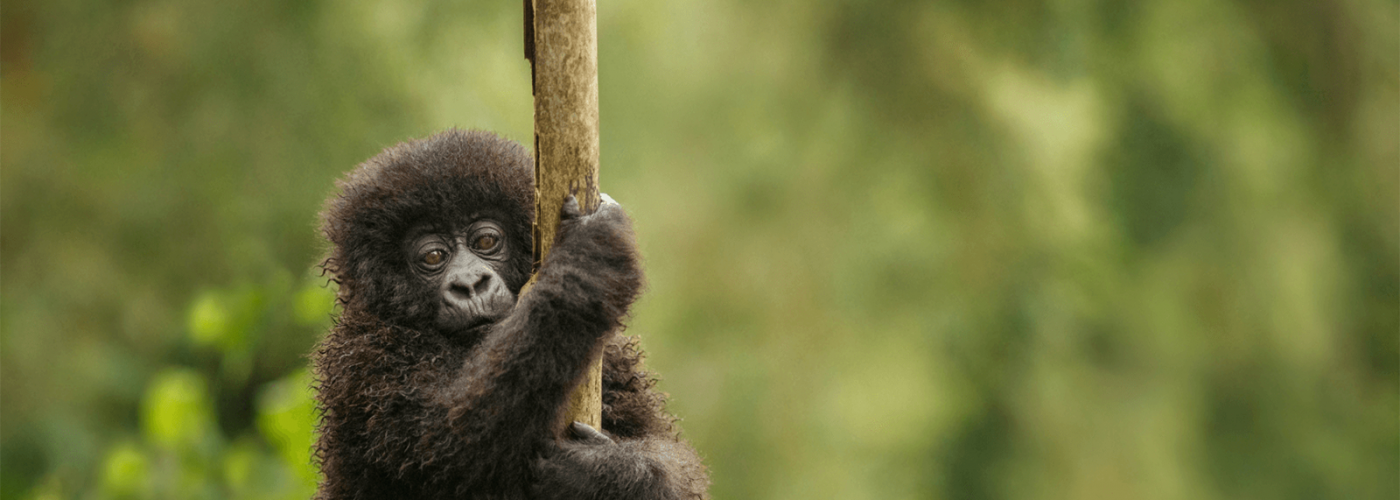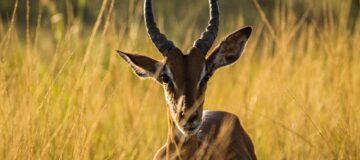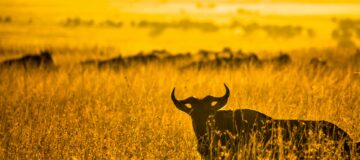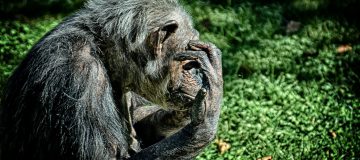Best Uganda Safaris 2025 / 2026

Uganda safaris are amazing. There is a lot of space and wilderness in this multi-award-winning East African destination. It is almost about the same size as the UK, but with a population of only over one million wild animals inclusive of over 6,000 apes and new world monkeys. The landscapes are a mix of astonishing contrasts with snow-capped mountains, serene sand beaches, dense tropical forests, open savannahs, and of course the spectacular freshwater lakes and rivers.
From a safari point of view, Uganda is a country of two halves as it lies across the equator, the Northern hemisphere, and the Southern hemisphere. Both zones are immensely gifted by nature as reflected in their awe-inspiring beauty and plentiful wildlife. However, there are some big variances when it comes to the type of Uganda safari experience they offer.
Southern Uganda Safari hemisphere
The Southern Uganda safari hemisphere is the place to be if you are looking for a phenomenal primate experience and illustrious scenery. Bwindi Impenetrable National Park is its jewel in the crown as it possesses over 50% of the world’s only surviving population of mountain gorillas.
Here, the ranger guides will often take you off the tracks and across the river that runs through the forest to get the best views of one of the 18 habituated families that freely roam the park. An encounter with all these families is unforgettable as they comprise members of different age brackets.
Bwindi is one of the only four parks in the world with this species, one of the others being Mgahinga National Park which is also found in the same country. The scenic beauty and sense of isolation of its four vegetation zones make it so hard to leave out on many people’s itinerary.
Regardless of whether you experience chimpanzee trekking at Kibale National Park or Budongo Forest, your chances of seeing chimps are very high. (while the former has over 1,100 members, the latter has 800+).
Both destinations are all a rainforest that should be mystical, dense, and full of refreshing rivers. You have a good chance to see its habituated families at ground level because even though they feed and sleep in the trees, they come down to groom and cool off. To get the prettiest poses, keep your camera in automatic mode.
Other parks you will find in this region include Queen Elizabeth National Park, a Big 5 destination with a rich concentration of picturesque crater lakes and lush savannah.
It is found along the same road that passes by Lake Mburo National Park, a herbivore-rich habitat. And for something completely different, there is Mountain Rwenzori, a 3 million-year-old snow caped gem that prides itself in being the third highest mountain in Africa, standing at 5,109 meters above sea level.
One of the things that all the parks here share in common is an abundance of cozy safari lodges. This region is one of the best places in all of Africa to also go bird watching as it is blessed with over 600 species.
The one-stop place to find most of them is Tooro-Semuliki Wildlife Reserve. It can be visited at any time of year (except for rainy April). Other highlights you will find at this geothermal park include elephants, buffalos, antelopes, waterbucks, chimpanzees, red-tailed and vervet monkeys, olive baboons, and black-and-white colobus, de brazza monkey, and dents mona.
Northern Uganda Safari hemisphere
The Northern Uganda safari part of the country is a dream-come-true destination for anyone with a soft spot for less crowded parks but with a healthy concentration of the Big 5.
It is far less visited and espouses a powerful sense of wilderness and wildness. From the huge wilderness expanses of the Kidepo Valley National Park to the massive giraffe herds that roam across Murchison Falls National Park and the Ziwa ecosystem, this is an extraordinary region indeed.
All these parks offer wide, empty spaces, impressive scenery, starry skies, and serenity. The Northern Uganda safari hemisphere is a photographer’s dream come true and will effortlessly draw you back for a return visit.
Karamoja cultural hub in the far northeast is a top getaway, with its nomadic warriors and iconic traditional ways of life. It is a perfect place to round off an incredibly memorable safari extravaganza in this amazingly diverse region.
Bwindi Impenetrable National Park
Bwindi Impenetrable National Park is an exceptionally beautiful UNESCO World Heritage Site; a magnificent green swathe of tangled rainforest on the steep ridges of the Western Rift Valley.
It ranks as the destination with the highest number of habituated mountain gorillas in the world, numbering over 250 members belonging to 18 families. The ones that are still 100% wild are over 210 as the latest reports by Uganda Wildlife Authority.
Trekking to see birds here is a remarkable experience. The guides know where to find the different kinds of birds found here although not all the 350 sightings are guaranteed. The park is blessed with all the 23 Albertine Rift Endemics.
Sitting at 1,160m – 2,607m above sea level, Bwindi is also one of the most extensive and ecologically diverse forests in Africa, boasting of over 400 plant species that have survived the ice age.
Though the park was gazetted in the early ’90s, it is over 25,000 years old and provides shelter to a further 120 mammals. This includes several primate species such as chimpanzees, baboons, vervets, and black & white monkeys, as well as forest elephants, buffaloes, and antelopes.
In the interest of better management, its 331Km2 expanse is divided into four trailheads. These are Buhoma, Ruhija, Nkuringo and Rushaga. If you wish to have a hustle-free trek, Buhoma and Rushaga is a favorable option due to its relatively gentle gradient.
To hike out and look back at the way their forested slopes climb up the steep Albertine escarpment is a treasured experience.
On the other hand, Nkuringo and Ruhija is a cup of coffee for anyone who loves climbing challenges. Finding its gorilla families is quite a tough scramble up and down wet and slippery hills through the dense undergrowth.
However, that all adds to the achievement. Nothing beats the excitement that comes at that moment when the ranger guide leading your group halts abruptly in front of you, cautiously sniffs and listens to the crisp air, asks you to sink to the ground, and gently points to a gorilla family.
Bwindi sits in the extreme West of the country towards the border with Congo. Luckily, it can be accessed by a scheduled daily flight of two hours from Entebbe Airport.
However, most visitors prefer to access it by road as it is connected by a well-maintained tarmac road from Kampala. En route, you will find lots of astonishing attractions such as Lake Mburo National Park, Igongo Museum, Queen Elizabeth National Park, and the Equator.
On average, the gorilla trek lasts half a day depending on how fast the gorillas are moving while foraging. You don’t need scientific expertise to recognize their distinctive pants, vocalizations, and screams.
Besides chimpanzees, other primates found here include vervet monkeys, olive baboons, and black and white monkeys. Many of the travelers we have brought here find the Lakes in the Southern section of the park enchanting.
In most cases, they can’t help it sit on the beach at sunset and watch the lanterns of hundreds of small wooden boats bobbing on the lake like a sprawling city.
Gorilla Habituation
One of Bwindi’s biggest competitive advantages over Volcanoes National Park is the unmatched gorilla habituation experience it offers.
It’s an exhilarating alternative – instead of just one hour, you will have four hours starting from when you reach the nesting where a particular family of absolutely wild gorillas spent the previous night.
You will actually track them with their trackers, unlike regular tracking where you’re simply led to where a habituated group at a random site where they are roaming.
It’s an immersive encounter, at times tense, and often exhausting. Nonetheless, the rewards far exceed the efforts. That’s why it costs $1500. However, that is the same price that you’d pay in Rwanda for regular tracking of a habituated family.
Budongo Forest
For anyone who loves chimpanzee trekking or watching primates, this is a destination not to be missed.
It is a favorite habitat for several other monkey species present, including black and white monkeys, which are often hunted by chimpanzees for their tasty meat.
Budongo Forest can easily be visited en route to Murchison Falls National Park. Actually, the road to Murchison runs through the forest. The massive ironbark trees are a sight to behold, several of them are over 250 years and still growing strong.
By the same token, the birdlife in the forest is both colorful and plentiful. Budongo also has impressive mahoganies that stand up to 60m tall. Their buttressed bases are often used as drums by roaming chimps.
Prepare to be blown away by the chimpanzees as they frolic through the forest. They move with amazing speed and agility. A basic level of physical fitness is enough for you to dash through the forest to keep up with a family group.
During your visit to Murchison, you will depart very early in the morning considering that people who start tracking too late often end up not finding the chimps.
And with the time and money needed to visit here, that’s a risk you shouldn’t take. The good news is that there is a rustic chalet/lodge at the heart of the forest where you can stay if you don’t want to wake up very early.
Now known as Budongo Eco-Lodge, it is that it once served as the station for Dr. Jane Goodall during her research on the chimps prior to 2000.
Bird watching
If you are looking for a great spot for bird-watching Budongo, its Busingiro zone is much more reliable than Kaniyo Pabidi. It is home to the so-called Royal Mile near Nyabyere Forestry College – a haven that scores highly in terms of rarities and visibility.
Of the 360 bird species on its checklist, 60 are west or central African birds. The forest is the second most important in Uganda (after Semuliki National Park) for species of the Guinea-Congo forest region.
Two species of birds found in the Budongo forest are found nowhere else in East Africa: Yellow-footed Flycatcher and Puvel’s illadopsis.
According to majority of twitchers who have been to Uganda, it is arguably the single best bird watching site in Uganda.
Kibale National Park
If you’re reading this then you’re probably trying to decide which of Kibale’s chimpanzee experiences to pursue.
The answer probably comes down to simply how much time you have available and, perhaps more importantly, how much money you have at your disposal.
First forward, Kibale lies on a plateau at the edge of the Albertine Rift Valley. The forest is lush and packed with over 200 species of trees.
Several streams that are fed by the glaciers of the nearby mountain Rwenzori run through the park while making their way to the scenic craters in Kibale’s neighborhood.
This is Uganda’s most important refuge for chimpanzees, supporting the biggest chimpanzee population in the country, currently estimated at around 1000. This includes both wild and communities that have been habituated for research purposes since the 1970s.
Chimpanzee habituation
This adventure entails spending a day with ranger guides in the forest as you discover purely wild chimpanzees that haven’t yet been tamed for tourism.
It’s physically demanding as these groups aren’t as calm. They move fast. The objective is to move with them as they go about their wild agendas.
You will stay in their sight so that they gradually get used to having people around. In the interest of minimizing the exposure of the chimps to human infections such as COVID, visitors are advised to keep a magical seven-meter distance from them.
Chimpanzee treks
Chimpanzee treks last an average of four hours, roughly three of which you will spend hiking to and fro the forest. The time you will spend with chimps in this case is limited to one hour and costs $150 as the habituation goes for $220.
This doesn’t necessarily mean the chimp trek comes down to domesticated families. On the contrary, in as much as they are well habituated, they hardly bat an eyelid at human presence.
There’s a good chance they’ll walk right past you, maybe even brushing against you as they go.
Bird watching
Kibale also doubles as an A-list destination for bird watching due to its number of rare birds and also the great visibility. That aside, there are no big hills to climb here.
Over 370 species have been recorded here, most of which are forest specials, including the sought-after African pitta. It’s the only park in Uganda where you stand a chance of encountering Cassin’s spinetail, Masked Apalis, blue-headed bee-eater, and Nahan’s francolin.
Migratory birds are present from November to April. To see those that you might miss out on seeing in the park, we shall organize for you an excursion to Bigodi Wetland Sanctuary – a community project.
Kyambura Gorge
Found in Queen Elizabeth National Park, Kyambura is a stunning geological wonder, a vast underground forest at the heart of the rift valley.
It has been attracting primate lovers for decades as it is home to a habituated gorilla family that is comprised of about 12 members.
Its spectacular, remote, and wild state qualify it as one of those popular places on the trekking trail that has to be seen with your own eyes.
Kyambura features a wooden hiking trail and bridges that run along its roaring river, enabling one to explore the site. This makes it one of the most beautiful places to meet our closest living relatives.
Mgahinga National Park
Mgahinga is Uganda’s smallest park, covering 33.7km2. Located in South Western Uganda towards its border with Congo and Rwanda, it is comprised of three free-standing volcanoes that rise to an altitude of 2,227m and 4,127m.
These are Mountain Mgahinga, Sabyinyo, and Muhavura, all of which adjoins the parks across the borders of Congo and Rwanda. The park boasts incredible vantage points to admire the soaring beauty of the Virunga region and its wonders especially crater lakes and a mix of both dormant and active volcanoes.
Mgahinga’s golden monkeys are the main attraction, but the park is also home to a family of habituated gorillas known as the Nyakagezi group.
Comprised of 11 members, they usually dwell in the bamboo zone or forest zone of the park depending on the time of the year.
An up-close encounter with these endangered giants is an experience like no other and anyone who has the chance shouldn’t pass up the opportunity.
Other wildlife found here include elephants, black-and-white monkeys, forest buffalo, and at least 12 bird species endemic to the Albertine Rift.
Because there is no lodge on its mountains, most people who come here for mountain climbing summit it in one day. The best part of the story is that you can also do it regardless of your level of fitness.
It takes just about eight hours for a to and fro hike, inclusive of stopovers. This doesn’t mean that you should rush your hike. On the contrary, take things slow. This will minimize your possibility of succumbing to altitude sickness.
If you come here for an encounter with the golden monkeys, you will explore some of the less known jungle trails.
The further you go, the more you get engulfed by that feeling that you might at any moment bump into gorillas.
Ngamba Chimpanzee Sanctuary/Island
Situated on a lush island in Lake Victoria, Ngamba Chimpanzee Sanctuary is a fully-fledged destination where you can see over 51 habituated chimpanzees in a wild setting.
It is a rehabilitation center for chimpanzees that were rescued from poachers or the black markets of Congo, Sudan, and the Central African Republic.
Its establishment was initiated by Debbie Cox along with Dr. Jane Goodall. To get to this fully-fledged destination, you will pursue a 45min boat ride from the Northern hemisphere of Lake Victoria to its Southern hemisphere.
Upon setting foot on the island, you will be welcomed by caregivers who are truly passionate about conservation.
They will orient you to the facility and give you a brief tour before inviting you to a raised viewing deck from where you can witness how the chimps co-relate during their feeding time.
Unlike other zoo facilities where the movement of animals is limited because they are caged in, where they spend much of the day roaming freely in a natural forest setting that is blessed with wild fruits.
For an extra $5 donation, you can join in feeding them by tossing fruits into their territory.
The next part of the tour entails visiting a lab, where health checks are performed on all chimps by specially-trained veterinarians, alongside experts in primate biology and behavior.
If you choose to sleep on-site at one of the luxurious bandas, you will have an opportunity to join in feeding them early morning.
Best times to visit
The dry time of year from December to February and June to August provide the most rewarding wildlife viewing encounters.
Forest adventures such as gorilla trekking and chimpanzee tracking are a big part of any safari in Uganda.
The tropical rainforests where they live are, by default, very wet, and one can’t avoid rain completely. Nonetheless, after a heavy shower, the skies often open up to bright sunshine.
























